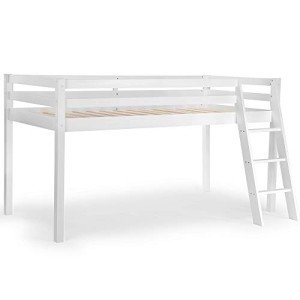20 Inspiring Quotes About UK Bunk Beds
Understanding UK Bunk Beds : A Comprehensive Guide
Bunk beds have become a popular option for lots of households throughout the United Kingdom. They use a reliable solution for saving space, accommodating multiple sleepers, and including a component of enjoyable to a child's room. With different designs, materials, and safety features offered, choosing the right bunk bed can be intimidating. This short article aims to provide a thorough check out UK bunk beds, covering their types, advantages, safety requirements, and acquiring pointers.
The Types of Bunk Beds
When it pertains to bunk beds, the choices are virtually endless. The primary classifications include:
1. Standard Bunk Beds
These are the timeless style, including two beds stacked one on top of the other. Standard bunk beds are best for siblings sharing a space or sleepovers.
2. Loft Beds
Loft beds rise beds without a lower bunk. This design offers adequate space below for a research study location, additional storage, or play space for children.
3. L-Shaped Bunk Beds
These beds have an L-shape design, enabling them to suit corners or odd areas in a space. They are often perfect for larger spaces and offer flexibility in sleeping plans.
4. Triple Bunk Beds
Developed for bigger families, triple bunk beds accommodate three sleeping spaces. These beds provide vertical sleeping arrangements and can be an excellent option for taking full advantage of room capacity.
5. Futon Bunk Beds
These versatile beds integrate a standard upper bunk with a futon or sofa below. This style can be used for sleeping or seating, making it a multifunctional choice for smaller spaces.
6. Bunk Beds with Storage
Some contemporary bunk beds come equipped with drawers or shelving, providing extra storage space for clothing, toys, or books. This function is especially beneficial in spaces that need arranged storage solutions.
Benefits of Bunk Beds
Bunk beds use numerous benefits, making them a preferable option for numerous homes:
Space-Saving: Bunk beds utilize vertical space, permitting more open floor location in smaller rooms.
Price: Sharing a room and buying one bunk bed can be more economical than purchasing separate beds for numerous kids.
Fun Factor: Bunk beds offer a sense of adventure and excitement, especially for children, making bedtime more pleasurable.
Versatile Layouts: With different styles available, bunk beds can fit any space design, ensuring design and functionality.
Storage Options: Many styles integrate additional storage options, helping to keep spaces neat.
Advantages of Bunk Beds
Description
Space-Saving
Uses vertical space to maximize floor location.
Cost
More economical for households with multiple children.
Enjoyable Factor
Adds excitement to bedtime and promotes creative play.
Versatile Layouts
Combinations can fit various room configurations.
Storage Options
Built-in drawers and racks help keep products organized.
Security Standards
When selecting bunk beds, safety should be a leading priority, especially for kids. The UK has actually developed policies to ensure that bunk beds meet specific safety requirements. For instance:
Guardrails: Beds ought to have guardrails on both sides of the top bunk to avoid accidental falls.
Bed mattress Size: Beds ought to be compatible with a proper mattress size to ensure safe use. The bed mattress must not exceed the top of the guardrails.
Strong Construction: Bunk beds need to be made from resilient materials to endure regular usage, guaranteeing stability and longevity.
Weight Limit: Every bunk bed has a weight limitation which need to be adhered to for security reasons.
Assembly Instructions: Proper assembly is crucial; follow the producer's guidelines carefully to make sure structural stability.
Buying Tips
When set to buy a bunk bed, consider the following points:
Room Size: Measure the room measurements to ensure the chosen bed fits easily.
Height Consideration: Ensure there is sufficient space above the leading bunk to avoid bumps on the ceiling.
Material Choice: Look for tough materials with a quality finish. Wood and metal are popular alternatives, with each providing various aesthetic appeals and toughness.
Safety Features: Verify that the bed meets safety requirements and has appropriate guardrails and a strong ladder.
Style Compatibility: Select a style that matches the existing decoration of the space.
Budget: Set a spending plan before exploring your choices, as bunk beds can cover a broad cost range.
Regularly Asked Questions (FAQs)
1. What age is suitable for a leading bunk?
Generally, children aged six and older can sleep on the top bunk, but always inspect specific manufacturer guidelines for age recommendations.
2. How do I maintain my bunk bed?
Regularly check for any loose screws or parts, clean the bed periodically, and guarantee it remains steady.
3. Can bunk beds accommodate adults?
While some bunk beds are created for heavier weights, the majority are mainly intended for kids. Inspect the weight limits if considering adult use.
4. Are bunk beds easy to put together?
A lot of bunk beds come with in-depth assembly directions and all required tools. Nevertheless, some designs might require expert assembly.
5. Can I utilize a thicker mattress on a bunk bed?
It is vital to follow the manufacturer's guidelines concerning bed mattress thickness to ensure safety and compliance with the guardrails.
Bunk beds are a flexible and useful alternative for households wanting to make the most of space and produce a fun sleeping environment for their children. With a myriad of designs available, it's essential to think about the specific needs of the household while focusing on safety and comfort. By understanding the numerous types, advantages, and important considerations surrounding bunk beds, parents can make educated choices that will improve their kids's living areas.
